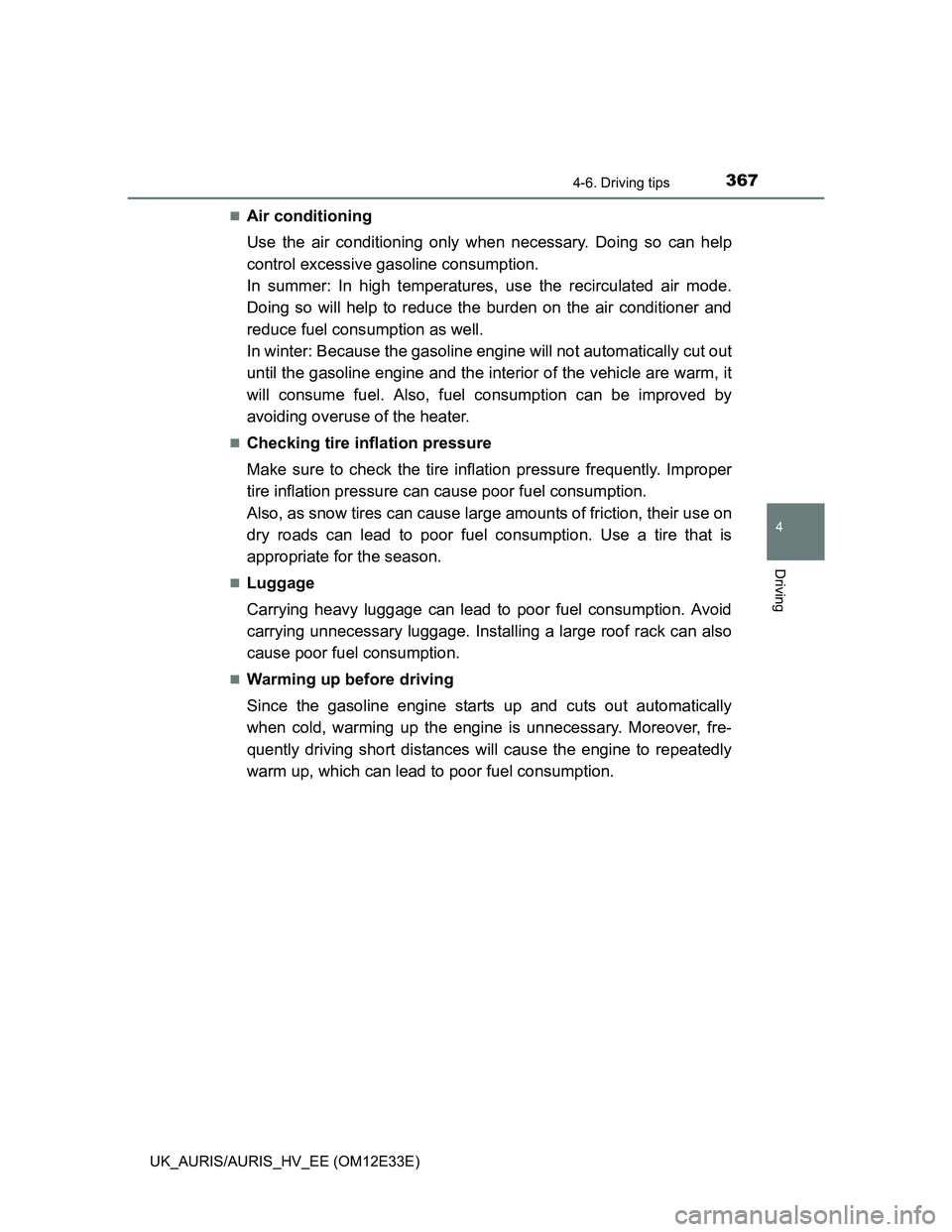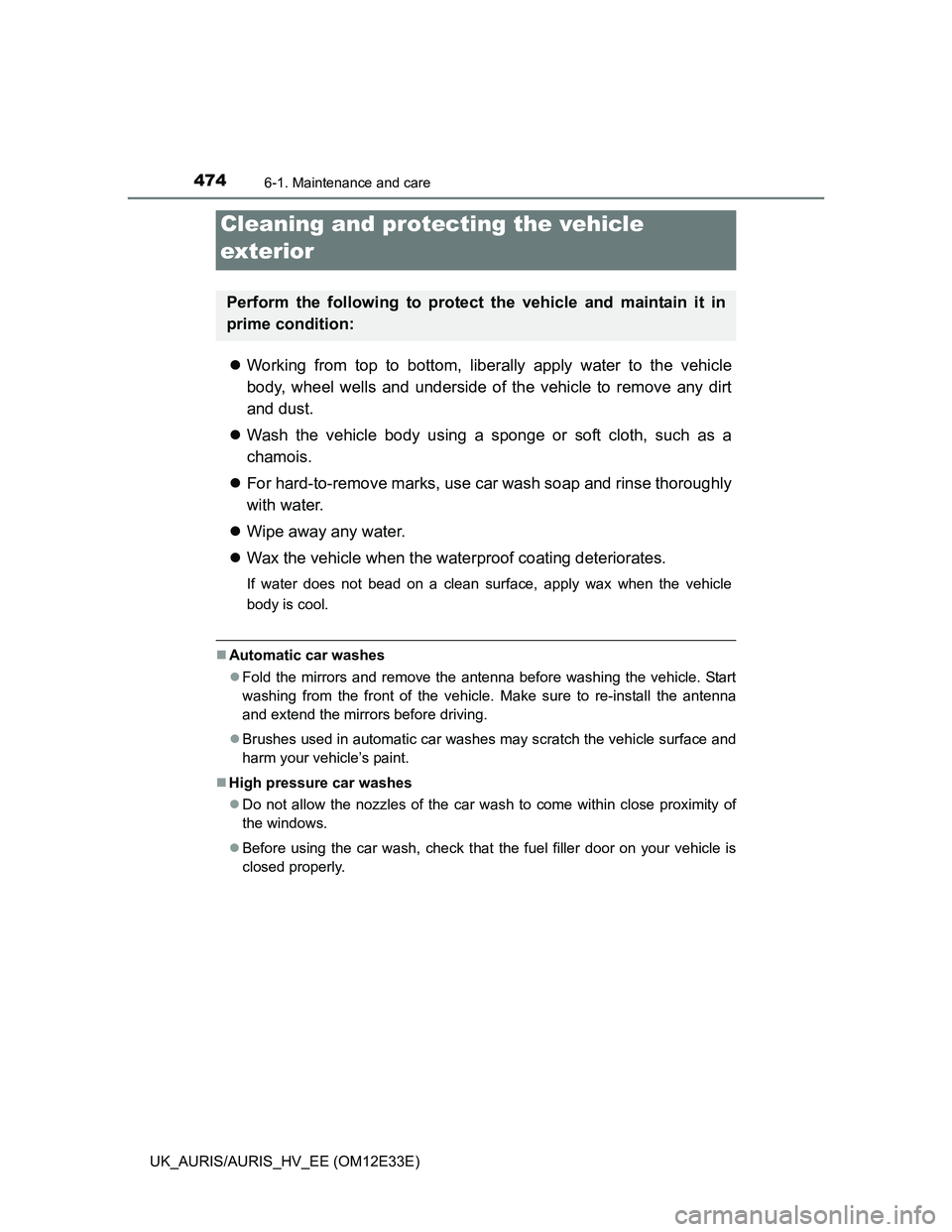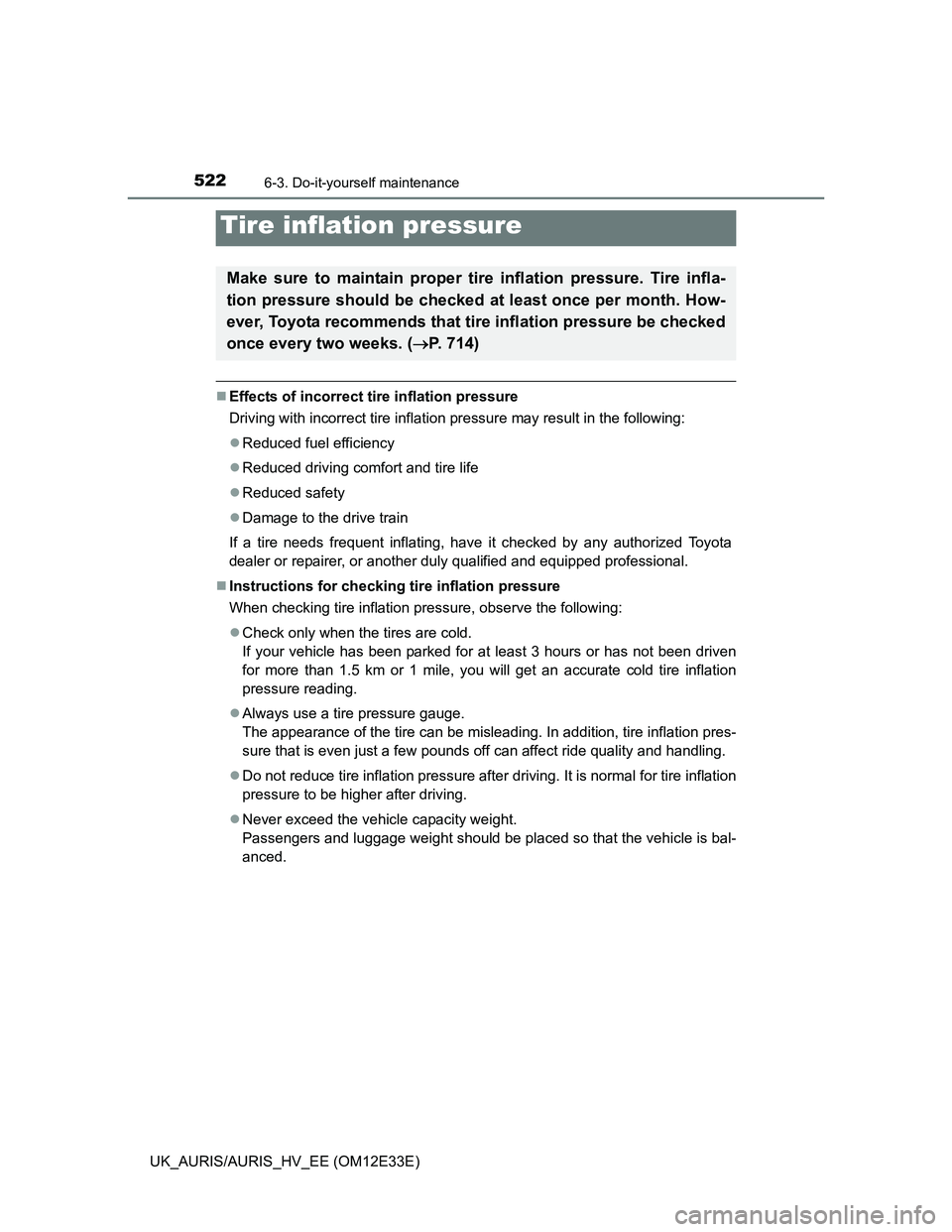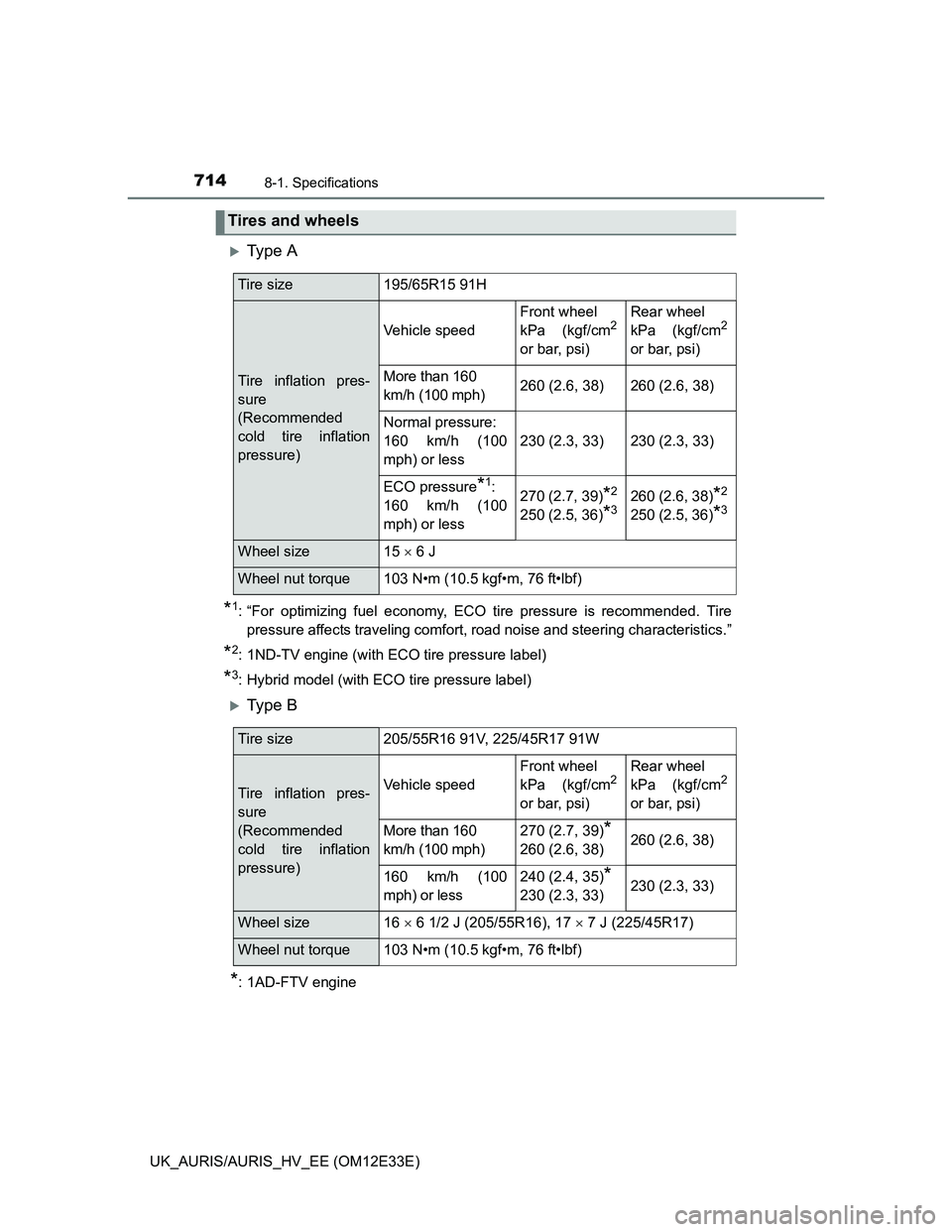2012 TOYOTA AURIS fuel pressure
[x] Cancel search: fuel pressurePage 7 of 750

5
1
8 7
6
5
4
3
2
UK_AURIS/AURIS_HV_EE (OM12E33E)6-1. Maintenance and care
Cleaning and protecting
the vehicle exterior ..........474
Cleaning and protecting
the vehicle interior ...........478
6-2. Maintenance
Maintenance
requirements....................481
6-3. Do-it-yourself
maintenance
Do-it-yourself service
precautions ......................484
Hood ..................................488
Positioning a floor jack .......490
Engine compartment..........492
12-volt battery ....................514
Tires ...................................519
Tire inflation pressure ........522
Wheels ...............................524
Air conditioning filter ..........526
Wireless remote control/
electronic key battery.......529
Checking and replacing
fuses ................................532
Light bulbs .........................5557-1. Essential information
Emergency flashers .......... 572
If your vehicle has to
be stopped in an
emergency ...................... 573
7-2. Steps to take in an
emergency
If your vehicle needs to
be towed ......................... 575
If you think something is
wrong .............................. 583
Fuel pump shut off
system............................. 584
If a warning light turns
on or a warning buzzer
sounds ............................ 585
If a warning message is
displayed ......................... 599
If you have a flat tire
(vehicles with a
spare tire) ........................ 626
If you have a flat tire
(vehicles with an
emergency tire puncture
repair kit) ......................... 638
If the engine will not
start ................................. 664
If the hybrid system will
not start ........................... 666
6Maintenance and care7When trouble arises
Page 17 of 750

15Pictorial index
UK_AURIS/AURIS_HV_EE (OM12E33E)Windshield wipers . . . . . . . . . . . . . . . . . . . . . . . . . . . . . . . . . P. 312
Precautions against winter season . . . . . . . . . . . . . . . . . . . . . P. 368
Precautions against car wash . . . . . . . . . . . . . . . . . . . . . . . . . P. 476
Fuel filler door . . . . . . . . . . . . . . . . . . . . . . . . . . . . . . . . . . . . P. 318
Refueling method . . . . . . . . . . . . . . . . . . . . . . . . . . . . . . . . . . P. 318
Fuel type/fuel tank capacity . . . . . . . . . . . . . . . . . . . . . . . . . . . P. 703
Tires . . . . . . . . . . . . . . . . . . . . . . . . . . . . . . . . . . . . . . . . . . . . P. 519
Tire size/inflation pressure . . . . . . . . . . . . . . . . . . . . . . . . . . . . P. 714
Winter tires/tire chain . . . . . . . . . . . . . . . . . . . . . . . . . . . . . . . . P. 368
Checking/rotation. . . . . . . . . . . . . . . . . . . . . . . . . . . . . . . . . . . P. 519
Coping with flat tires . . . . . . . . . . . . . . . . . . . . . . . . . . . . . . . . P. 626
Hood . . . . . . . . . . . . . . . . . . . . . . . . . . . . . . . . . . . . . . . . . . . . P. 488
Opening . . . . . . . . . . . . . . . . . . . . . . . . . . . . . . . . . . . . . . . . . . P. 488
Engine oil . . . . . . . . . . . . . . . . . . . . . . . . . . . . . . . . . . . . . . . . . P. 705
Coping with overheat . . . . . . . . . . . . . . . . . . . . . . . . . . . . . . . . P. 685
Headlights . . . . . . . . . . . . . . . . . . . . . . . . . . . . . . . . . . . . . . . P. 300
Front position lights/daytime running lights . . . . . . . . . . . P. 300
Front fog lights
*1/rear fog light . . . . . . . . . . . . . . . . . . . . . . P. 310
Turn signal lights . . . . . . . . . . . . . . . . . . . . . . . . . . . . . . . . . . P. 297
Stop/tail lights . . . . . . . . . . . . . . . . . . . . . . . . . . . . . . . . . . . . P. 300
Hill-start assist control
*1 . . . . . . . . . . . . . . . . . . . . . . . . . . . . . P. 362
License plate lights . . . . . . . . . . . . . . . . . . . . . . . . . . . . . . . . P. 300
Back-up light
Shifting the shift lever to R. . . . . . . . . . . . . . . . P. 276, 281, 286, 289
Rear view monitor system camera
*1, 3
4
5
6
7
Light bulbs of the exterior lights for driving
(Replacing method: P. 555, Watts: P. 716)
*1: If equipped
*2: Vehicles with a multi-information display
*3: Refer to ““touch screen” Owner’s manual”.
8
9
10
11
12
13
14
15
Page 119 of 750

1172. Instrument cluster
UK_AURIS/AURIS_HV_EE (OM12E33E)
2
Instrument cluster
Warning lights inform the driver of malfunctions in the indicated vehi-
cle’s systems.
Warning lights
*1, 2
(Red)
Brake system warning
light (P. 585)*4, 7
(Yellow)
Cruise control indicator
light (P. 589)
*2
(Yellow)
Brake system warning
light (hybrid model)
(P. 589)*4, 6
(Yellow)
Smart entry & start sys-
tem indicator light
(P. 589)
*1, 3Charging system warn-
ing light (P. 586)*1, 3Fuel filter warning light
(diesel engine)
(P. 589)
*1, 3Low engine oil pressure
warning light (P. 586)*3Open door warning light
(P. 590)
*1, 3High engine coolant
temperature warning
light (P. 586)Low fuel level warning
light (P. 590)
*1Multi-mode manual
transmission warning
light (vehicles with a
multi-mode manual
transmission) (P. 587)
Driver’s and front pas-
senger’s seat belt
reminder light (P. 590)
*1, 2Malfunction indicator
lamp (P. 588)Rear passengers’ seat
belt reminder lights
(P. 590)
*1, 2SRS warning light
(P. 588)*1, 3Low engine oil level
warning light (diesel
engine) (P. 590)
*1, 2ABS warning light
(P. 588)*1, 3Engine oil change
reminder light (diesel
engine)
(P. 591, 592, 592)
*1, 2Electric power steering
system warning light
(P. 588)*1, 2, 8Master warning light
(P. 593)
Page 369 of 750

3674-6. Driving tips
UK_AURIS/AURIS_HV_EE (OM12E33E)
4
Driving
Air conditioning
Use the air conditioning only when necessary. Doing so can help
control excessive gasoline consumption.
In summer: In high temperatures, use the recirculated air mode.
Doing so will help to reduce the burden on the air conditioner and
reduce fuel consumption as well.
In winter: Because the gasoline engine will not automatically cut out
until the gasoline engine and the interior of the vehicle are warm, it
will consume fuel. Also, fuel consumption can be improved by
avoiding overuse of the heater.
Checking tire inflation pressure
Make sure to check the tire inflation pressure frequently. Improper
tire inflation pressure can cause poor fuel consumption.
Also, as snow tires can cause large amounts of friction, their use on
dry roads can lead to poor fuel consumption. Use a tire that is
appropriate for the season.
Luggage
Carrying heavy luggage can lead to poor fuel consumption. Avoid
carrying unnecessary luggage. Installing a large roof rack can also
cause poor fuel consumption.
Warming up before driving
Since the gasoline engine starts up and cuts out automatically
when cold, warming up the engine is unnecessary. Moreover, fre-
quently driving short distances will cause the engine to repeatedly
warm up, which can lead to poor fuel consumption.
Page 476 of 750

474
UK_AURIS/AURIS_HV_EE (OM12E33E)
6-1. Maintenance and care
Working from top to bottom, liberally apply water to the vehicle
body, wheel wells and underside of the vehicle to remove any dirt
and dust.
Wash the vehicle body using a sponge or soft cloth, such as a
chamois.
For hard-to-remove marks, use car wash soap and rinse thoroughly
with water.
Wipe away any water.
Wax the vehicle when the waterproof coating deteriorates.
If water does not bead on a clean surface, apply wax when the vehicle
body is cool.
Automatic car washes
Fold the mirrors and remove the antenna before washing the vehicle. Start
washing from the front of the vehicle. Make sure to re-install the antenna
and extend the mirrors before driving.
Brushes used in automatic car washes may scratch the vehicle surface and
harm your vehicle’s paint.
High pressure car washes
Do not allow the nozzles of the car wash to come within close proximity of
the windows.
Before using the car wash, check that the fuel filler door on your vehicle is
closed properly.
Cleaning and protecting the vehicle
exterior
Perform the following to protect the vehicle and maintain it in
prime condition:
Page 524 of 750

5226-3. Do-it-yourself maintenance
UK_AURIS/AURIS_HV_EE (OM12E33E)
Effects of incorrect tire inflation pressure
Driving with incorrect tire inflation pressure may result in the following:
Reduced fuel efficiency
Reduced driving comfort and tire life
Reduced safety
Damage to the drive train
If a tire needs frequent inflating, have it checked by any authorized Toyota
dealer or repairer, or another duly qualified and equipped professional.
Instructions for checking tire inflation pressure
When checking tire inflation pressure, observe the following:
Check only when the tires are cold.
If your vehicle has been parked for at least 3 hours or has not been driven
for more than 1.5 km or 1 mile, you will get an accurate cold tire inflation
pressure reading.
Always use a tire pressure gauge.
The appearance of the tire can be misleading. In addition, tire inflation pres-
sure that is even just a few pounds off can affect ride quality and handling.
Do not reduce tire inflation pressure after driving. It is normal for tire inflation
pressure to be higher after driving.
Never exceed the vehicle capacity weight.
Passengers and luggage weight should be placed so that the vehicle is bal-
anced.
Tire inflation pressure
Make sure to maintain proper tire inflation pressure. Tire infla-
tion pressure should be checked at least once per month. How-
ever, Toyota recommends that tire inflation pressure be checked
once every two weeks. (P. 714)
Page 716 of 750

7148-1. Specifications
UK_AURIS/AURIS_HV_EE (OM12E33E)
Ty p e A
*1: “For optimizing fuel economy, ECO tire pressure is recommended. Tire
pressure affects traveling comfort, road noise and steering characteristics.”
*2: 1ND-TV engine (with ECO tire pressure label)
*3: Hybrid model (with ECO tire pressure label)
Ty p e B
*: 1AD-FTV engine
Tires and wheels
Tire size195/65R15 91H
Tire inflation pres-
sure
(Recommended
cold tire inflation
pressure)
Vehicle speed
Front wheel
kPa (kgf/cm2
or bar, psi)
Rear wheel
kPa (kgf/cm2
or bar, psi)
More than 160
km/h (100 mph)260 (2.6, 38)260 (2.6, 38)
Normal pressure:
160 km/h (100
mph) or less
230 (2.3, 33)230 (2.3, 33)
ECO pressure*1:
160 km/h (100
mph) or less270 (2.7, 39)*2
250 (2.5, 36)*3260 (2.6, 38)*2
250 (2.5, 36)*3
Wheel size15 6 J
Wheel nut torque103 N•m (10.5 kgf•m, 76 ft•lbf)
Tire size205/55R16 91V, 225/45R17 91W
Tire inflation pres-
sure
(Recommended
cold tire inflation
pressure)Vehicle speed
Front wheel
kPa (kgf/cm2
or bar, psi)
Rear wheel
kPa (kgf/cm2
or bar, psi)
More than 160
km/h (100 mph)270 (2.7, 39)*
260 (2.6, 38)260 (2.6, 38)
160 km/h (100
mph) or less240 (2.4, 35)*
230 (2.3, 33)230 (2.3, 33)
Wheel size16 6 1/2 J (205/55R16), 17 7 J (225/45R17)
Wheel nut torque103 N•m (10.5 kgf•m, 76 ft•lbf)
Page 739 of 750

737Alphabetical index
UK_AURIS/AURIS_HV_EE (OM12E33E)
Engine oil.................................. 497
Capacity ................................ 705
Checking ............................... 497
Oil level warning message .... 602
Oil pressure warning
message ............................. 600
Preparing and checking
before winter ....................... 368
Engine switch................... 254, 258
EPS (Electric Power
Steering) ................................. 356
Function ................................ 356
Warning light ......................... 588
EV drive mode .......................... 274
Flat tire
Vehicles with a spare tire ...... 626
Vehicles without a spare
tire....................................... 638
Floor mats .................................. 38
Fluid
Multidrive............................... 711
Brake..................................... 713
Washer.................................. 511
Fog lights.................................. 310
Replacing light bulbs ............. 555
Switch ................................... 310
Wattage................................. 716Follow me home system ......... 302
Front fog lights ........................ 310
Replacing light bulbs............. 555
Switch ................................... 310
Wattage ................................ 716
Front personal lights ............... 442
Front position lights ................ 300
Light switch ........................... 300
Replacing light bulbs............. 555
Front seats ............................... 208
Adjustment ............................ 208
Cleaning................................ 478
Correct driving posture ........... 40
Head restraints ..................... 212
Seat heaters ......................... 465
Front turn signal lights ........... 297
Replacing light bulbs............. 555
Turn signal lever ................... 297
Wattage ................................ 716
Fuel ........................................... 318
Capacity ................................ 703
Fuel gauge ............................ 122
Fuel pump shut off system.... 584
Information ............................ 717
Refueling............................... 318
Type .............................. 318, 703
Warning light ......................... 590
Fuel filler door.......................... 318
Refueling............................... 318
Fuel pump shut off system ..... 584
Fuses ........................................ 532
Gauges ............................. 122, 126
Gear Shift Indicator ................. 283
Glove box ................................. 446
F
G